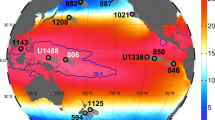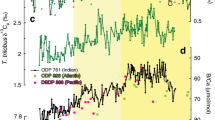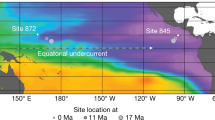Abstract
In the present-day climate, surface water salinities are low in the western tropical Pacific Ocean and increase towards the eastern part of the basin1. The salinity of surface waters in the tropical Pacific Ocean is thought to be controlled by a combination of atmospheric convection, precipitation, evaporation and ocean dynamics2, and on interannual timescales significant variability is associated with the El Niño/Southern Oscillation cycles. However, little is known about the variability of the coupled ocean–atmosphere system on timescales of centuries to millennia. Here we combine oxygen isotope and Mg/Ca data from foraminifers retrieved from three sediment cores in the western tropical Pacific Ocean to reconstruct Holocene sea surface temperatures and salinities in the region. We find a decrease in sea surface temperatures of ∼0.5 °C over the past 10,000 yr, whereas sea surface salinities decreased by ∼1.5 practical salinity units. Our data imply either that the Pacific basin as a whole has become progressively less salty or that the present salinity gradient along the Equator has developed relatively recently.
This is a preview of subscription content, access via your institution
Access options
Subscribe to this journal
Receive 51 print issues and online access
$199.00 per year
only $3.90 per issue
Buy this article
- Purchase on Springer Link
- Instant access to full article PDF
Prices may be subject to local taxes which are calculated during checkout



Similar content being viewed by others
References
Levitus, S. & Boyer, T. P. World Ocean Atlas 1994 Vol. 3, Salinity (NOAA Atlas NESDIS, US Department of Commerce, Washington DC, 1994)
Cronin, M. F. & McPhaden, M. J. Upper ocean salinity balance in the western equatorial Pacific. J. Geophys. Res. 103, 27567–27587 (1998)
Sun, D.-Z. & Trenberth, K. E. Coordinated heat removal from the equatorial Pacific during the 1986–87 El Niño. Geophys. Res. Lett. 25, 2659–2662 (1998)
McPhaden, M. J. Genesis and evolution of the 1997–98 El Niño. Science 283, 950–954 (1999)
Aggarwal, P. K., Fröhlich, K., Kulkarni, K. M. & Gourcy, L. L. Stable isotope evidence for moisture sources in the Asian summer monsoon under present and past climate regimes. Geophys. Res. Lett. 31, doi:10.1029/2004GL019911 (2004).
Fairbanks, R. G. et al. Evaluating climate indices and their geochemical proxies measured in corals. Coral Reefs 16, S93–S100 (1997)
Morimoto, M. et al. Salinity records for the 1997-98 El Niño from Western Pacific corals. Geophys. Res. Lett. 29, doi:10.1029/2001GL013521 (2002)
Nürnberg, D., Bijma, J. & Hemleben, C. Assessing the reliability of magnesium in foraminiferal calcite as a proxy of water mass temperature. Geochim. Cosmochim. Acta 60, 803–814 (1996)
Lea, D. W., Pak, D. K. & Spero, H. J. Climate impact of late Quaternary equatorial Pacific sea surface temperature variations. Science 289, 1719–1724 (2000)
Oppo, D. W., Linsley, B. K., Rosenthal, Y., Dannenmann, S. & Beaufort, L. Orbital and suborbital climate variability in the Sulu Sea, western tropical Pacific. Geochem. Geophys. Geosyst. 4, doi:1029/2001GC000260 (2003).
Fairbanks, R. A 17,000-year glacio-eustatic sea level record: influence of glacial melting rates on the Younger Dryas event and deep-ocean circulation. Nature 342, 637–642 (1989)
Clement, A. C., Seager, R. & Cane, M. A. Orbital controls on the El Niño/Southern Oscillation and the tropical climate. Paleoceanography 14, 441–456 (1999)
Gagan, M. K. et al. Temperature and surface-ocean water balance of the mid-Holocene tropical western Pacific. Science 279, 1014–1018 (1998)
Liu, Z., Kutzbach, J. & Wu, L. Modeling climate shift of El Niño variability in the Holocene. Geophys. Res. Lett. 27, 2265–2268 (2000)
Schmittner, A., Appenzeller, Z. & Stocker, T. F. Enhanced Atlantic freshwater export during El Niño. Geophys. Res. Lett. 27, 1163–1166 (2000)
Prell, W. L. & Van Campo, E. Coherent response of Arabian Sea upwelling and pollen transport to late Quaternary monsoonal winds. Nature 323, 526–528 (1986)
DeMenocal, P., Ortiz, J., Guilderson, T. & Sarnthein, M. Coherent high- and low-latitude climate variability during the Holocene warm period. Science 288, 2198–2202 (2000)
Haug, G. H. et al. Southward migration of the Intertropical Convergence Zone through the Holocene. Science 293, 1304–1308 (2001)
Waelbroeck, C. et al. Sea-level and deep water temperature changes derived from benthic foraminifera isotopic records. Quat. Sci. Rev. 21, 295–305 (2002)
Acknowledgements
We thank M. Rincon for analytical assistance. This research was supported by the US-NSF-OCE.
Author information
Authors and Affiliations
Corresponding author
Ethics declarations
Competing interests
The authors declare that they have no competing financial interests.
Supplementary information
Supplementary Figure
This figure displays the AMS 14C ages for samples from sites discussed in the text. These AMS-depth values were used to calculate sediment accumulation rates for the sites and to estimate ages for samples through the core sequences. (DOC 33 kb)
Supplementary Table
Table of sample depth, age, G. ruber δ18Oc, G. ruber Mg/Ca, Mg/Ca-temperature estimate, and δ18OSW (SMOW) values calculated for samples from each of the Indonesian cores discussed in the manuscript. (XLS 92 kb)
Supplementary Discussion
This discussion describes how the age model for each site was established and gives details about the sediment accumulation rates in the Holocene. Details of the analytical methods are also described. (DOC 36 kb)
Rights and permissions
About this article
Cite this article
Stott, L., Cannariato, K., Thunell, R. et al. Decline of surface temperature and salinity in the western tropical Pacific Ocean in the Holocene epoch. Nature 431, 56–59 (2004). https://doi.org/10.1038/nature02903
Received:
Accepted:
Issue Date:
DOI: https://doi.org/10.1038/nature02903
This article is cited by
-
Mid-to-late Holocene climate variability in coastal East Asia and its impact on ancient Korean societies
Scientific Reports (2023)
-
Holocene millennial-scale megaflood events point to ENSO-driven extreme climate changes
Science China Earth Sciences (2023)
-
Mid-Holocene precipitation variations in the Luoyang Basin within the Central Plains of China: a pollen-based reconstruction
Climate Dynamics (2023)
-
Holocene thermal maximum mode versus the continuous warming mode: Problems of data-model comparisons and future research prospects
Science China Earth Sciences (2023)
-
Last glacial temperature reconstructions using coupled isotopic analyses of fossil snails and stalagmites from archaeological caves in Okinawa, Japan
Scientific Reports (2021)
Comments
By submitting a comment you agree to abide by our Terms and Community Guidelines. If you find something abusive or that does not comply with our terms or guidelines please flag it as inappropriate.



